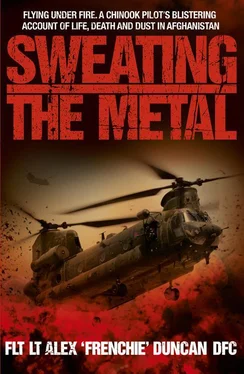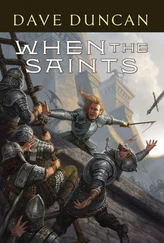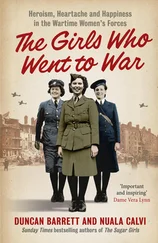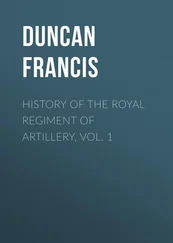Hellfire AGM-114N: Enhanced blast version of Hellfire air-to-surface missiles carried by Apache AH-1.
Hesco Bastion: Square wire mesh cubes lined with hessian. Filled with sand and/or rubble and used as defensive ramparts to protect bases from fire.
HLS: Helicopter Landing Site.
HRF:Helmand Reaction Force.
ICOM: Radio scanner used by Coalition and Taliban forces to monitor one another’s radio transmissions.
ICOM chatter: Intelligence Communication. Term for intercepts of Taliban radio chatter.
IED: Improvised Explosive Device.
Illume: Term given to light conditions for night flying in theatre. Green illume signifies good vision using NVGs; red illume signifies no vision, even with NVGs.
Intel: Intelligence.
IR: Infrared.
IRT: Incident Response Team consisting of aircrew, medical team, EOD (bomb disposal) team and fire rescue team. The medical team is made up of a surgeon/anaesthetist, paramedics and emergency-care specialist nurses. Protected on the ground by Quick Reaction Force.
ISAF: International Security Assistance Force. NATO multinational military force in Afghanistan.
ISTAR: Intelligence, Surveillance, Target Acquisition and Reconnaissance – a practice that links several battlefield functions together to assist a combat force in employing its sensors and managing the information they gather.
JDAM: Joint Direct Attack Munition. Guidance system bolted on to 500lb or 2,000lb bomb to make it an accurate, all-weather weapon.
JHC: Joint Helicopter Command. UK-based command for all British military helicopters in the UK and overseas.
JHF (A): Joint Helicopter Force (Afghanistan). Main at KAF, ‘Forward’ at Bastion. Afghanistan helicopter HQ operating under authority of JHC.
JOC: Joint Operations Centre. The control centre of operations in Helmand Province.
JTAC: Joint Terminal Attack Controller, also known as FAC, or Forward Air Controller. A soldier responsible for the delivery of air ordnance on to a target by combat aircraft. Call sign normally ‘Widow’.
KAF: Kandahar Airfield.
KIA: Killed in Action.
Klick: Military slang for kilometres.
LAW: Light Anti-Tank Weapon. A portable one-shot, disposable 66mm unguided anti-tank rocket launcher; pre-loaded w/HEAT rocket.
LCJ: Load Carrying Jacket.
Lockheed AC-130 Spectre: A heavily-armed ground-attack aircraft based on the Hercules C-130 airframe.
M60D: 7.62mm automatic, gas-operated machine-gun mounted on the Chinook’s rear ramp. Rate of fire of up to 550 rounds per minute.
M134 Minigun: 7.62 mm, multi-barrel machine-gun with a high rate of fire (up to 4,000 rounds per minute), employing Gatling-style rotating barrels, either battery- or externally-powered. Fitted to forward side doors of RAF CH47 Chinooks.
Max Chat: A euphemism for full power or top speed, the term originates from World War II when most aircraft were piston engined. It stands for Maximum Cylinder Head Air Temperature.
MERT: Medical Emergency Response Team or Combat Air Ambulance based at Camp Bastion.
Military Cross: Third-level decoration awarded in recognition of gallantry during active operations.
NVG: Night-Vision Goggles. Optical instrument that magnifies available light by 50,000 times.
OC: Officer Commanding – Wing Commander in charge of a Squadron.
Operation Herrick: British codename for all military operations in Afghanistan.
Operation Telic: British codename for all military operations in Iraq.
PHF: Passenger Handling Facility at Bastion.
Paradigm: Prime contractor for the Skynet 5 contract with the MoD. It enables military personnel deployed on two to six-month tours to make thirty minutes of Government-funded phone calls to any location in the world each week.
Pinzgauer: High Mobility All-Terrain 4x4 and 6x6 military utility vehicles with open backs, covered by a canvas roof. Used alongside or in place of the Land Rover Defender as a patrol vehicle.
QRF: Quick Reaction Force. Members of RAF Regiment or Army used to provide force protection on IRT missions.
R&R: Rest and Recuperation; a fourteen-day break from deployment given to everyone in theatre on a six-month tour.
RadAlt: Radar Altimeter, cockpit instrument that measures altitude above the terrain beneath an aircraft.
RAF Regiment: The RAF’s own military corps responsible for force protection, airfield defence, forward air control and parachute capability.
RIP: Relief in Place – one aircraft replacing another over the battlefield.
RoC: Rehearsal of Concept.
Rock Ape: Colloquial term used within the RAF for members of the RAF Regiment.
RoE: Rules of Engagement. Laws set by a country’s Government laying down rules for the use and proportionality of arms and military force.
RPG: Rocket-Propelled Grenade. Soviet-designed, shoulder-launched rocket with a powerful grenade warhead.
SAFIRE: Small arms fire.
Tracer: Bullets coated with phosphorous paint that burns with a red, orange or green glow. Usually loaded every fourth round to check trajectory and accuracy of fire.
USL: Underslung load.
Wingman: The other aircraft in a pair.
Yaw: Side-to-side movement of the nose of an aircraft. Defines the aircraft’s heading.
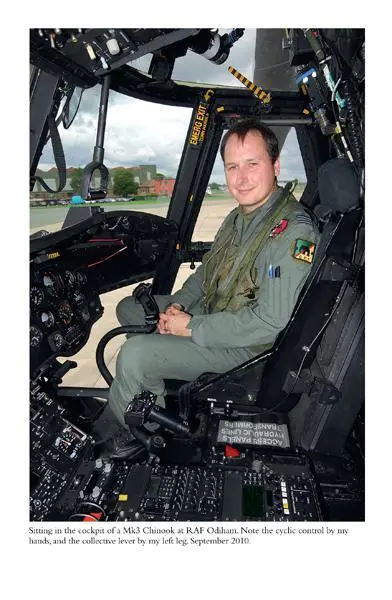
Sitting in the cockpit of a Mk3 Chinook at RAF Odiham. Note the cycle control by my hands, and the collective lever by my left leg. September 2010.
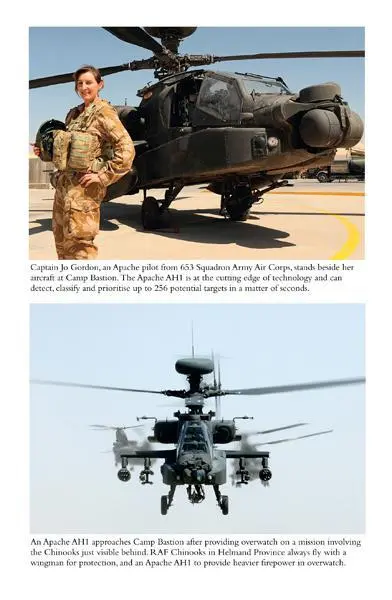
Captain Jo Gordon, an Apache pilot from 653 Squadron Army Air Corps, standing beside her aircraft at Camp Bastion. The Apache AH1 is at the cutting edge of technology and can detect, classify and prioritise up to 256 potential targets in a matter of seconds.
An Apache AH1 approaches Camp Bastion after providing overwatch on a mission involving the Chinooks just visible behind. RAF Chinooks in Helmand Province always fly with a wingman for protection, and an Apache AH1 to provide heavier firepower in overwatch.
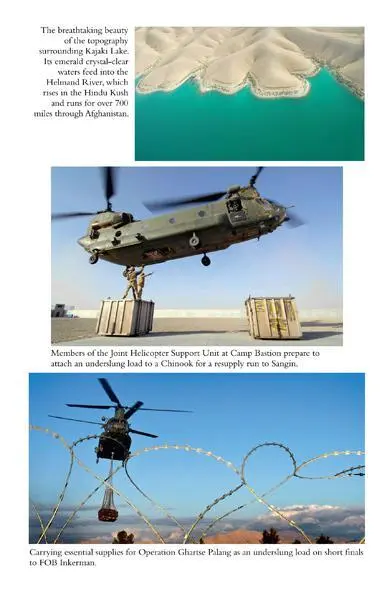
The breathtaking beauty of the topography surrounding Kajaki Lake. Its emerald crystal-clear waters feed into the Helmand River, which rises in the Hindu Kush and runs for over 70 miles through Afghanistan.
Members of the Joint Helicopter Support Unit at Camp Bastion prepare to attach an underslung load to a Chinook for a resupply run to Sangin.
Carrying essential supplies for Operation Ghartse Palang as an underslung load on short finals to FOB Inkerman.
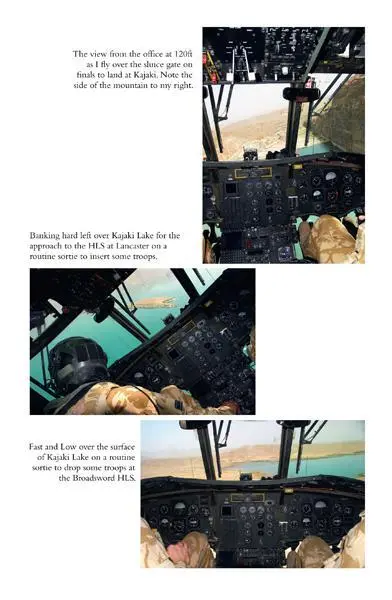
The view from the office at 120ft as I fly over the sluice gate on finals to land at Kajaki. Note the side of the mountain to my right.
Banking hard left over Kajaki Lake for the approach to the HLS at Lancaster on a routine sortie yo insert some troops.
Fast and Low over the surface of Kajaki Lake on a routine sortie to drop some troops at Broadsword HLS.
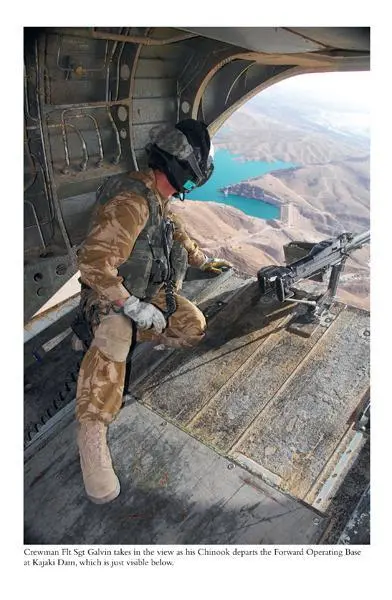
Crewman Flt Sgt Galvin takes in the view as his Chinook departs the Forward Operating Base at Kajaki Dam, which is just visible below.
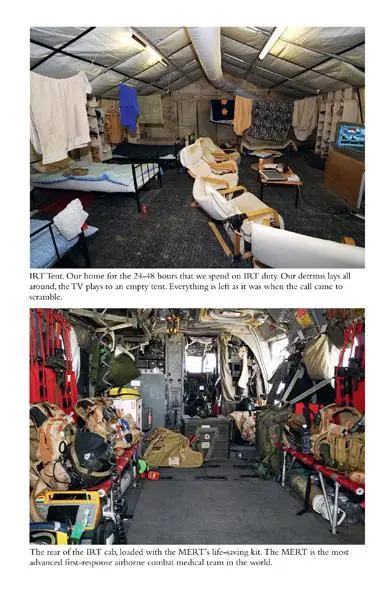
IRT tent. Our home for the 24–48 hours that we spend on IRT duty. Our detritus lays all around, the TV plays to an empty tent. Everything is left as it was when the call came to scramble.
The rear of the IRT cab, loaded with the MERT’s life-saving kit. The MERT is the most advanced first-response airborne combat medical team in the world.
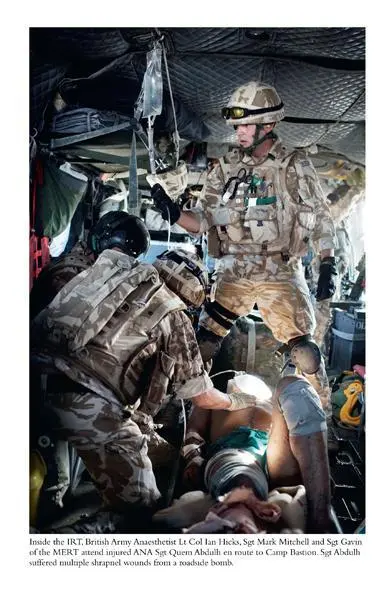
Inside the IRT, British Army Anaesthetist Lt Col Ian Hicks, Sgt Mark Mitchell and Sgt Gavin of the MERT attend injured ANA Sgt Quem Abdulh en route to Camp Bastion. Sgt Abdulh suffered multiple shrapnel wounds from a roadside bomb.
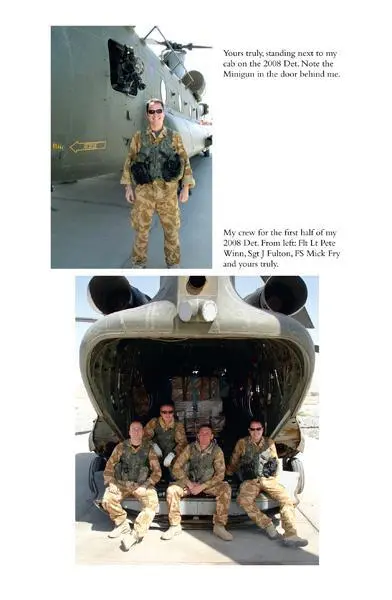
Yours truly, standing next to my cab on the 2008 Det. Note the Minigun in the door behind me.
My crew for the first half of my 2008 Det. From left: Flt Lt Pete Winn, Sgt J Fulton, FS Mick Fry and yours truly.
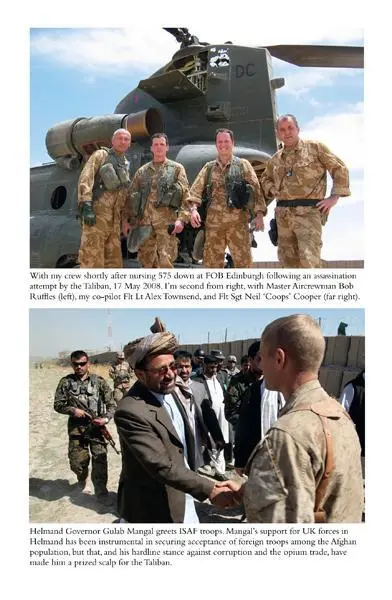
With my crew shortly after nursing 575 down at FOB Edinburgh following an assassination attempt by the Taliban, 17 Mat 2008. I’m second from right, with Master Aircrewman Bob Ruffles (left), my co-pilot Flt Lt Alex Townsend, and Flt Sgt Neil ‘Coops’ Cooper (far right).
Helmand Governor Gulab Mangal greets ISAF troops. Mangal’s support for UK forces in Helmand has been instrumental in securing acceptance of foreign troops among the Afghan population, but that, and his hardline stance against corruption and the opium trade, have made him a prized scalp for the Taliban.
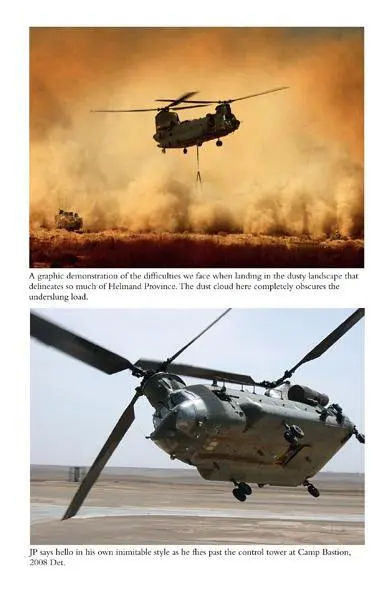
A graphic demonstration of the difficulties we face when landing in the dusty landscape that delineates so much of Helmand Province. That dust cloud here completely obscures the underslung load.
JP says hello in his own inimitable style as he flies past the control tower at Camp Bastion, 2008 Det.
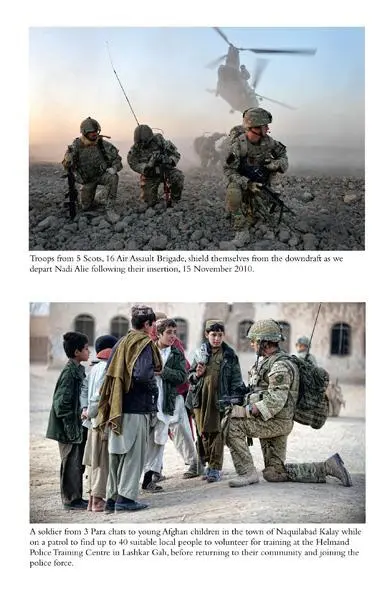
Troops from 5 Scots, 16 Air Assault Brigade, shield themselves from the downdraft as we depart Nadi Alie following their insertion, 15 November 2010.
A soldier from 3 Para chats to young Afghan children in the town of Naquilabad Kalay while on a patrol to find up to 40 suitable local people for training at the Helmand Police Training Centre in Lashkar Gah, before returning to their community and joining the police force.
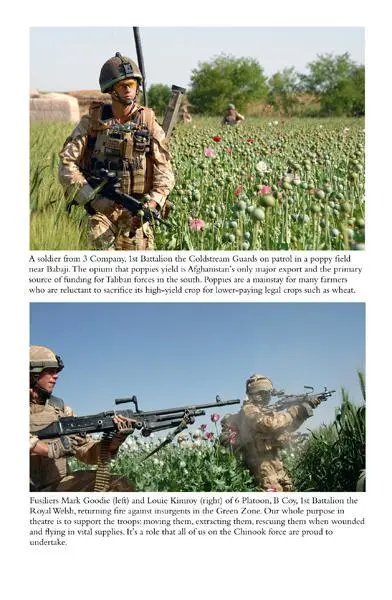
A soldier from 3 Company, 1st Battalion the Coldsream Guards on patrol in a poppy field near Babaji. The opium that poppies yield is Afghanistan’s only major export and the primary source of funding for Taliban forces in the south. Poppies are mainstay for many farmers who are reluctant to sacrifice its high-yield crop for lower-paying legal crops such as wheat.
Fusiliers Mark Goodie (left) and Louie Kinsroy (right) of 6 Platoon, B Coy, 1st Battalion the Royal Welsh, returning fire against insurgents in the Green Zone. Our whole purpose in theatre is to support the troops: moving them, extracting them, rescuing them when wounded and flying in vital supplies. It’s a role that all as on the Chinook force are proud to undertake.
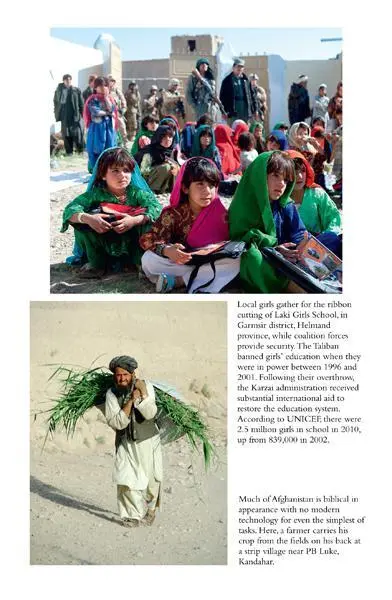
Local girls gather for the ribbon cutting of Laki Girls School, in Garmsir district, Helmand province, while coalition forces provides security. The Taliban banned girls’ education when they were in power between 1996 and 2001. Following their overthrow, the Karzai administration received substantial international aid to restore the education system. According to UNICEF, there were 2.5 million girls in school in 2010, up from 839,000 in 2002.
Читать дальше
